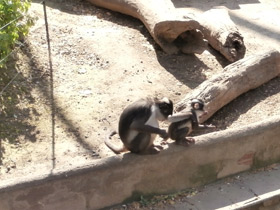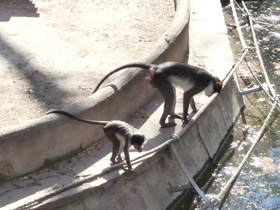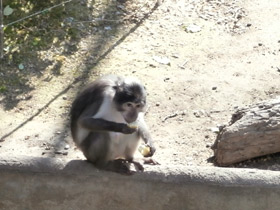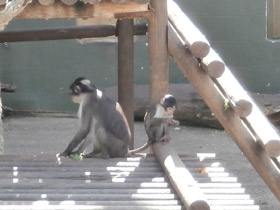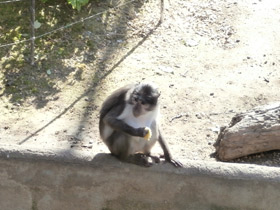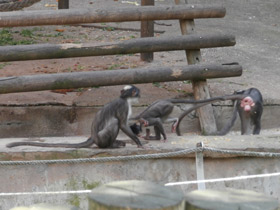The genus Cercocebus (The white-eyelid mangabeys)
Cercocebus atys lunulatus (now Cercocebus lunulatus)
The white-eyelid mangabeys are African Old World monkeys belonging to the genus Cercocebus. They are characterized by their bare upper eyelids, which are lighter than their facial skin colouring, and the uniformly coloured hairs of the fur. The other two genera of mangabeys, Lophocebus and Rungwecebus, were once thought to be very closely related to Cercocebus, so much so that all the species were placed in one genus, but Lophocebus and Rungwecebus species are now understood to be more closely related to the baboons in genus Papio, while the Cercocebus species are more closely related to the mandrill.
Habitat area
Cercocebus are common tree monkeys in central and western Africa. They are named after the Madagascan town of Mangabeya, from where they were first brought to Europe.
Appearance
Cercocebus is a genus of catarrhine primates in the family Cercopithecidae that includes six African species known by the common name of white-eyed mangabeys. Cercocebus is a fairly large monkey, with a slender body, long limbs and a long tail. Its body length varies from 40 to 80 cm, and its tail is much longer than its body. The forelimbs of Cercocebus are shorter than the hind limbs, and there are skin membranes between the toes. The skull and snout of these primates are elongated, not closer to monkeys, but to macaques. Teeth like those of macaques: the lower third molar with five tubercles.
The colouring of Cercocebus varies from dark grey to chestnut and light brown; on the neck and shoulders the hair is elongated, on the head there is often a cap or crest.
Cercocebus is generally divided into two groups: common white-necked mangobea and crested Cercocebus. In the first group, the fur on the body is short, the colouring is predominantly dark grey, the limbs are darker than the body; there is no crest on the upper part, but the cap on the head differs dramatically from the general colour.
Species
- Cercocebus agilis Milne-Edwards, 1886 - Agile Mangabey;
- Cercocebus atys Audebert, 1797 - Sooty Mangabey;
- Cercocebus chrysogaster Lydekker, 1900;
- Cercocebus galeritus Peters, 1879 - Crested Mangabey;
- Cercocebus sanjei Mittermeier, 1986;
- Cercocebus torquatus Kerr, 1792 - Red-capped Mangabey;
- Cercocebus atys lunulatus or Cercocebus lunulatus.
Cercocebus atys lunulatus (now Cercocebus lunulatus)
Cercocebus atys lunulatus, now Cercocebus lunulatus, is commonly known as the white-crowned, white-naped, or white-collared mangabey (leading to confusion with the collared mangabey). This now distinct species is considered to have a geographic range east of the Sassandra River to the west of the Volta River in Ghana; Cercocebus lunulatus is also recorded as inhabiting forests in southwestern Burkina Faso and northeastern Ivory Coast. Cercocebus lunulatus is considered Endangered by the IUCN.
Distribution and appearance
Cercocebus lunulatus is a species of catarrhine primate in the family Cercopithecidae. Cercocebus atys is common on the west coast of Africa from Senegal to Ghana, including Burkina Faso, Côte d'Ivoire, Guinea, Guinea-Bissau, Liberia and Sierra Leone.
It is a large primate: males can weigh up to 18 kg and females up to 12 kg. Its coat is short and dark smoky, with a yellowish-brown face and a dark brown "cap" on the head and pink face.
Behaviour and breeding
Cercocebus atys usually live in large groups of up to 35 individuals. They spend a lot of time on the ground, and only during rest or danger do they climb trees. Interestingly, these monkeys can swim. They have strong legs that allow them to crack nuts (other Cercocebus are unable to do so). The basic diet of the smoky Cercocebus atys consists of fruits and plant seeds, but 1-30% of its diet consists of invertebrates and small vertebrate animals.
Gestation lasts on average 5.5 months, after which a young is born. It begins to taste hard fruit at two weeks of age. From four to six weeks of age, the young are mobile, clinging to the fur on their mother's belly, and then lead a relatively independent life, but not completely separated from the female until 14 weeks of age. Puberty usually occurs at 3 years of age. The maximum lifespan of the smoky Cercocebus atys is 18 years.
Disease
Sooty mangabeys are naturally infected with a strain of Simian Immunodeficiency Virus (SIV), known as SIVsmm. Due to extensive human-mangabey contact in sub-Saharan Africa, SIVsmm has jumped from this species into humans on many occasions, resulting in HIV-2 virus. Because sooty mangabeys, as natural hosts of SIV, do not get sick from SIV, much research has been performed on the species for potential genetic resistance or immunological mechanisms. The HIV-1 strain by contrast came from the common chimpanzee strain of SIV.
Sooty mangabeys can also contract leprosy, caused by the bacterium Mycobacterium leprae. It is one of several species in which naturally acquired leprosy has been reported, the others being humans, the nine-banded armadillo, the common chimpanzee, and the crab-eating macaque; murine leprosy has also been reported in rats and mice, caused by Mycobacerium lepraemurium.
Conservation status
The sooty mangabey is believed to be decreasing in numbers as its forest habitat is degraded, with trees being felled for firewood and timber and forest habitats used for agriculture. Furthermore, sooty mangabeys are hunted for meat in some parts of its range, often at rates far exceeding the rate at which Sooty mangabeys can reproductively sustain themselves; this increase in hunting, especially with improved technology and an influx of human populations (and thus hunters), has become an increasing threat to the conservation of sooty mangabeys. The International Union for Conservation of Nature has assessed the conservation status of sooty mangabeys as Vulnerable.

















